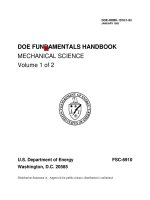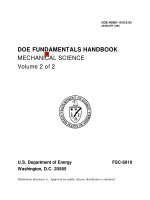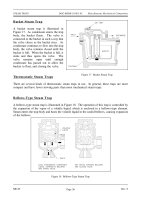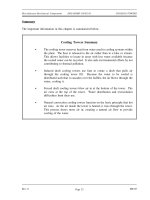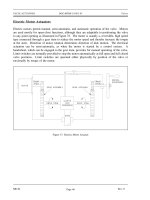Mechanical Science HandbooksMechanical Science Handbooks 10000 Part 5 pps
Bạn đang xem bản rút gọn của tài liệu. Xem và tải ngay bản đầy đủ của tài liệu tại đây (324.93 KB, 10 trang )
DOE-HDBK-1018/1-93
Diesel Engine Fundamentals FUNDAMENTALS OF THE DIESEL CYCLE
FUNDAMENTALS OF THE DIESEL CYCLE
Diesel engines operate under the principle of the internal combustion engine.
There are two basic types of diesel engines, two-cycle and four-cycle. An
understanding of how each cycle operates is required to understand how to
correctly operate and maintain a diesel engine.
EO 1.3 EXPLAIN how a diesel engine converts the chemical energy
stored in the diesel fuel into mechanical energy.
EO 1.4 EXPLAIN how the ignition process occurs in a diesel engine.
EO 1.5 EXPLAIN the operation of a 4-cycle diesel engine, including
when the following events occur during a cycle:
a. Intake
b. Exhaust
c. Fuel injection
d. Compression
e. Power
EO 1.6 EXPLAIN the operation of a 2-cycle diesel engine, including
when the following events occur during a cycle:
a. Intake
b. Exhaust
c. Fuel injection
d. Compression
e. Power
The Basic Diesel Cycles
A diesel engine is a type of heat engine that uses the internal combustion process to convert the
energy stored in the chemical bonds of the fuel into useful mechanical energy. This occurs in
two steps. First, the fuel reacts chemically (burns) and releases energy in the form of heat.
Second the heat causes the gasses trapped in the cylinder to expand, and the expanding gases,
being confined by the cylinder, must move the piston to expand. The reciprocating motion of
the piston is then converted into rotational motion by the crankshaft.
Rev. 0 ME-01
Page 21
DOE-HDBK-1018/1-93
FUNDAMENTALS OF THE DIESEL CYCLE Diesel Engine Fundamentals
To convert the chemical energy of the fuel into useful mechanical energy all internal combustion
engines must go through four events: intake, compression, power, and exhaust. How these
events are timed and how they occur differentiates the various types of engines.
All diesel engines fall into one of two categories, two-stroke or four-stroke cycle engines. The
word cycle refers to any operation or series of events that repeats itself. In the case of a four-
stroke cycle engine, the engine requires four strokes of the piston (intake, compression, power,
and exhaust) to complete one full cycle. Therefore, it requires two rotations of the crankshaft,
or 720° of crankshaft rotation (360° x 2) to complete one cycle. In a two-stroke cycle engine
the events (intake, compression, power, and exhaust) occur in only one rotation of the crankshaft,
or 360°.
Timing
In the following discussion of the diesel cycle it is important to keep in mind the time
frame in which each of the actions is required to occur. Time is required to move exhaust
gas out of the cylinder and fresh air in to the cylinders, to compress the air, to inject fuel,
and to burn the fuel. If a four-stroke diesel engine is running at a constant 2100
revolutions per minute (rpm), the crankshaft would be rotating at 35 revolutions, or
12,600 degrees, per second. One stroke is completed in about 0.01429 seconds.
The Four-Stoke Cycle
In a four-stroke engine the camshaft is geared so that it rotates at half the speed of the crankshaft
Figure 16 Scavenging and Intake
(1:2). This means that the crankshaft must make two complete revolutions before the camshaft
will complete one revolution. The following section will describe a four-stroke, normally
aspirated, diesel engine having both intake and exhaust valves
with a 3.5-inch bore and 4-inch stroke with a 16:1 compression
ratio, as it passes through one complete cycle. We will start on
the intake stroke. All the timing marks given are generic and
will vary from engine to engine. Refer to Figures 10, 16, and 17
during the following discussion.
Intake
As the piston moves upward and approaches 28° before
top dead center (BTDC), as measured by crankshaft
rotation, the camshaft lobe starts to lift the cam follower.
This causes the pushrod to move upward and pivots the
rocker arm on the rocker arm shaft. As the valve lash is
taken up, the rocker arm pushes the intake valve
downward and the valve starts to open. The intake
stroke now starts while the exhaust valve is still open.
The flow of the exhaust gasses will have created a low
ME-01 Rev. 0
Page 22
DOE-HDBK-1018/1-93
Diesel Engine Fundamentals FUNDAMENTALS OF THE DIESEL CYCLE
pressure condition within the cylinder and will help pull in the fresh air charge as shown
in Figure 16.
The piston continues its upward travel through top dead center (TDC) while fresh air
enters and exhaust gasses leave. At about 12° after top dead center (ATDC), the
camshaft exhaust lobe rotates so that the exhaust valve will start to close. The valve is
fully closed at 23° ATDC. This is accomplished through the valve spring, which was
compressed when the valve was opened, forcing the rocker arm and cam follower back
against the cam lobe as it rotates. The time frame during which both the intake and
exhaust valves are open is called valve overlap (51° of overlap in this example) and is
necessary to allow the fresh air to help scavenge (remove) the spent exhaust gasses and
cool the cylinder. In most engines, 30 to 50 times cylinder volume is scavenged through
the cylinder during overlap. This excess cool air also provides the necessary cooling
effect on the engine parts.
As the piston passes TDC and begins to travel down the cylinder bore, the movement of
the piston creates a suction and continues to draw fresh air into the cylinder.
Compression
At 35° after bottom dead center (ABDC), the intake
Figure 17 Compression
valve starts to close. At 43° ABDC (or 137° BTDC),
the intake valve is on its seat and is fully closed. At
this point the air charge is at normal pressure (14.7 psia)
and ambient air temperature (~80°F), as illustrated in
Figure 17.
At about 70° BTDC, the piston has traveled about 2.125
inches, or about half of its stroke, thus reducing the
volume in the cylinder by half. The temperature has now
doubled to ~160°F and pressure is ~34 psia.
At about 43° BTDC the piston has traveled upward 3.062
inches of its stroke and the volume is once again halved.
Consequently, the temperature again doubles to about
320°F and pressure is ~85 psia. When the piston has
traveled to 3.530 inches of its stroke the volume is again
halved and temperature reaches ~640°F and pressure 277 psia. When the piston has
traveled to 3.757 inches of its stroke, or the volume is again halved, the temperature
climbs to 1280°F and pressure reaches 742 psia. With a piston area of 9.616 in
2
the
pressure in the cylinder is exerting a force of approximately 7135 lb. or 3-1/2 tons of
force.
Rev. 0 ME-01
Page 23
DOE-HDBK-1018/1-93
FUNDAMENTALS OF THE DIESEL CYCLE Diesel Engine Fundamentals
The above numbers are ideal and provide a good example of what is occurring in an
engine during compression. In an actual engine, pressures reach only about 690 psia.
This is due primarily to the heat loss to the surrounding engine parts.
Fuel Injection
Figure 18 Fuel Injection
Fuel in a liquid state is injected into the cylinder at
a precise time and rate to ensure that the
combustion pressure is forced on the piston neither
too early nor too late, as shown in Figure 18. The
fuel enters the cylinder where the heated
compressed air is present; however, it will only
burn when it is in a vaporized state (attained
through the addition of heat to cause vaporization)
and intimately mixed with a supply of oxygen.
The first minute droplets of fuel enter the
combustion chamber and are quickly vaporized.
The vaporization of the fuel causes the air
surrounding the fuel to cool and it requires time
for the air to reheat sufficiently to ignite the
vaporized fuel. But once ignition has started, the
additional heat from combustion helps to further
vaporize the new fuel entering the chamber, as long as oxygen is present. Fuel
injection starts at 28° BTDC and ends at 3° ATDC; therefore, fuel is injected for
a duration of 31°.
Power
Both valves are closed, and the fresh air charge has
Figure 19 Power
been compressed. The fuel has been injected and
is starting to burn. After the piston passes TDC,
heat is rapidly released by the ignition of the fuel,
causing a rise in cylinder pressure. Combustion
temperatures are around 2336°F. This rise in
pressure forces the piston downward and increases
the force on the crankshaft for the power stroke as
illustrated in Figure 19.
The energy generated by the combustion process is
not all harnessed. In a two stroke diesel engine,
only about 38% of the generated power is
harnessed to do work, about 30% is wasted in the
form of heat rejected to the cooling system, and
about 32% in the form of heat is rejected out the
exhaust. In comparison, the four-stroke diesel
engine has a thermal distribution of 42% converted
ME-01 Rev. 0
Page 24
DOE-HDBK-1018/1-93
Diesel Engine Fundamentals FUNDAMENTALS OF THE DIESEL CYCLE
to useful work, 28% heat rejected to the cooling system, and 30% heat rejected
out the exhaust.
Exhaust
Figure 20 Exhaust
As the piston approaches 48° BBDC, the cam of the
exhaust lobe starts to force the follower upward, causing
the exhaust valve to lift off its seat. As shown in
Figure 20, the exhaust gasses start to flow out the exhaust
valve due to cylinder pressure and into the exhaust
manifold. After passing BDC, the piston moves upward
and accelerates to its maximum speed at 63° BTDC. From
this point on the piston is decelerating. As the piston
speed slows down, the velocity of the gasses flowing out
of the cylinder creates a pressure slightly lower than
atmospheric pressure. At 28° BTDC, the intake valve
opens and the cycle starts again.
The Two-Stroke Cycle
Like the four-stroke engine, the two-stroke engine must go
through the same four events: intake, compression, power, and exhaust. But a two-stroke engine
requires only two strokes of the piston to complete one full cycle. Therefore, it requires only one
rotation of the crankshaft to complete a cycle. This means several events must occur during each
stroke for all four events to be completed in two strokes, as opposed to the four-stroke engine
where each stroke basically contains one event.
In a two-stroke engine the camshaft is geared so that it rotates at the same speed as the
crankshaft (1:1). The following section will describe a two-stroke, supercharged, diesel engine
having intake ports and exhaust valves with a 3.5-inch bore and 4-inch stroke with a 16:1
compression ratio, as it passes through one complete cycle. We will start on the exhaust stroke.
All the timing marks given are generic and will vary from engine to engine.
Exhaust and Intake
At 82° ATDC, with the piston near the end of its power stroke, the exhaust cam begins
to lift the exhaust valves follower. The valve lash is taken up, and 9° later (91° ATDC),
the rocker arm forces the exhaust valve off its seat. The exhaust gasses start to escape
into the exhaust manifold, as shown in Figure 21. Cylinder pressure starts to decrease.
After the piston travels three-quarters of its (down) stroke, or 132° ATDC of crankshaft
rotation, the piston starts to uncover the inlet ports. As the exhaust valve is still open, the
uncovering of the inlet ports lets the compressed fresh air enter the cylinder and helps
cool the cylinder and scavenge the cylinder of the remaining exhaust gasses (Figure 22).
Commonly, intake and exhaust occur over approximately 96° of crankshaft rotation.
Rev. 0 ME-01
Page 25
DOE-HDBK-1018/1-93
FUNDAMENTALS OF THE DIESEL CYCLE Diesel Engine Fundamentals
At 43° ABDC, the camshaft starts to close the exhaust valve. At 53° ABDC (117°
BTDC), the camshaft has rotated sufficiently to allow the spring pressure to close the
exhaust valve. Also, as the piston travels past 48°ABDC (5° after the exhaust valve starts
closing), the intake ports are closed off by the piston.
Figure 21 2-Stroke Exhaust Figure 22 2-Stroke Intake
Compression
After the exhaust valve is on its seat (53° ATDC), the temperature and pressure begin to
rise in nearly the same fashion as in the four-stroke engine. Figure 23 illustrates the
compression in a 2-stroke engine. At 23° BTDC the injector cam begins to lift the
injector follower and pushrod. Fuel injection continues until 6° BTDC (17 total degrees
of injection), as illustrated in Figure 24.
ME-01 Rev. 0
Page 26
DOE-HDBK-1018/1-93
Diesel Engine Fundamentals FUNDAMENTALS OF THE DIESEL CYCLE
Figure 23 2-Stroke Compression Figure 24 2-Stroke Fuel Injection
Power
Figure 25 2-Stroke Power
The power stroke starts after the piston passes TDC.
Figure 25 illustrates the power stroke which continues
until the piston reaches 91° ATDC, at which point the
exhaust valves start to open and a new cycle begins.
Rev. 0 ME-01
Page 27
DOE-HDBK-1018/1-93
FUNDAMENTALS OF THE DIESEL CYCLE Diesel Engine Fundamentals
Summary
The important information in this chapter is summarized below.
Fundamentals of the Diesel Cycle Summary
Ignition occurs in a diesel by injecting fuel into the air charge which has been
heated by compression to a temperature greater than the ignition point of the
fuel.
A diesel engine converts the energy stored in the fuel's chemical bonds into
mechanical energy by burning the fuel. The chemical reaction of burning the
fuel liberates heat, which causes the gasses to expand, forcing the piston to
rotate the crankshaft.
A four-stroke engine requires two rotations of the crankshaft to complete one
cycle. The event occur as follows:
Intake - the piston passes TDC, the intake valve(s) open and the fresh air is
admitted into the cylinder, the exhaust valve is still open for a few degrees
to allow scavenging to occur.
Compression - after the piston passes BDC the intake valve closes and the
piston travels up to TDC (completion of the first crankshaft rotation).
Fuel injection - As the piston nears TDC on the compression stroke, the
fuel is injected by the injectors and the fuel starts to burn, further heating
the gasses in the cylinder.
Power - the piston passes TDC and the expanding gasses force the piston
down, rotating the crankshaft.
Exhaust - as the piston passes BDC the exhaust valves open and the
exhaust gasses start to flow out of the cylinder. This continues as the piston
travels up to TDC, pumping the spent gasses out of the cylinder. At TDC
the second crankshaft rotation is complete.
ME-01 Rev. 0
Page 28
DOE-HDBK-1018/1-93
Diesel Engine Fundamentals FUNDAMENTALS OF THE DIESEL CYCLE
Fundamentals of the Diesel Cycle Summary (Cont.)
A two-stroke engine requires one rotation of the crankshaft to complete one
cycle. The events occur as follows:
Intake - the piston is near BDC and exhaust is in progress. The intake
valve or ports open and the fresh air is forced in. The exhaust valves or
ports are closed and intake continues.
Compression - after both the exhaust and intake valves or ports are closed,
the piston travels up towards TDC. The fresh air is heated by the
compression.
Fuel injection - near TDC the fuel is injected by the injectors and the fuel
starts to burn, further heating the gasses in the cylinder.
Power - the piston passes TDC and the expanding gasses force the piston
down, rotating the crankshaft.
Exhaust - as the piston approaches BDC the exhaust valves or ports open
and the exhaust gasses start to flow out of the cylinder.
Rev. 0 ME-01
Page 29
DIESEL ENGINE SPEED, DOE-HDBK-1018/1-93 Diesel Engine Fundamentals
FUEL CONTROLS, AND PROTECTION
DIESEL ENGINE SPEED, FUEL CONTROLS,
AND PROTECTION
Understanding how diesel engines are controlled and the types of protective
instrumentation available is important for a complete understanding of the
operation of a diesel engine.
EO 1.7 DESCRIBE how the mechanical-hydraulic governor on a
diesel engine controls engine speed.
EO 1.8 LIST five protective alarms usually found on mid-sized and
larger diesel engines.
Engine Control
The control of a diesel engine is accomplished through several components: the camshaft, the fuel
injector, and the governor. The camshaft provides the timing needed to properly inject the fuel,
the fuel injector provides the component that meters and injects the fuel, and the governor
regulates the amount of fuel that the injector is to inject. Together, these three major components
ensure that the engine runs at the desired speed.
Fuel Injectors
Each cylinder has a fuel injector designed to meter and inject fuel into the cylinder at the proper
instant. To accomplish this function, the injectors are actuated by the engine's camshaft. The
camshaft provides the timing and pumping action used by the injector to inject the fuel. The
injectors meter the amount of fuel injected into the cylinder on each stroke. The amount of fuel
to be injected by each injector is set by a mechanical linkage called the fuel rack. The fuel rack
position is controlled by the engine's governor. The governor determines the amount of fuel
required to maintain the desired engine speed and adjusts the amount to be injected by adjusting
the position of the fuel rack.
Each injector operates in the following manner. As illustrated in Figure 26, fuel under pressure
enters the injector through the injector's filter cap and filter element. From the filter element the
fuel travels down into the supply chamber (that area between the plunger bushing and the spill
deflector). The plunger operates up and down in the bushing, the bore of which is open to the
fuel supply in the supply chamber by two funnel-shaped ports in the plunger bushing.
ME-01 Rev. 0
Page 30

